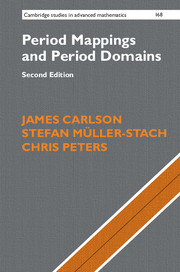Book contents
- Frontmatter
- Contents
- Preface to the Second Edition
- Preface to the First Edition
- PART ONE BASIC THEORY
- 1 Introductory Examples
- 2 Cohomology of Compact Kähler Manifolds
- 3 Holomorphic Invariants and Cohomology
- 4 Cohomology of Manifolds Varying in a Family
- 5 Period Maps Looked at Infinitesimally
- PART TWO ALGEBRAIC METHODS
- PART THREE DIFFERENTIAL GEOMETRIC METHODS
- PART FOUR ADDITIONAL TOPICS
- Appendix A Projective Varieties and Complex Manifolds
- Appendix B Homology and Cohomology
- Appendix C Vector Bundles and Chern Classes
- Appendix D Lie Groups and Algebraic Groups
- References
- Index
1 - Introductory Examples
from PART ONE - BASIC THEORY
Published online by Cambridge University Press: 30 August 2017
- Frontmatter
- Contents
- Preface to the Second Edition
- Preface to the First Edition
- PART ONE BASIC THEORY
- 1 Introductory Examples
- 2 Cohomology of Compact Kähler Manifolds
- 3 Holomorphic Invariants and Cohomology
- 4 Cohomology of Manifolds Varying in a Family
- 5 Period Maps Looked at Infinitesimally
- PART TWO ALGEBRAIC METHODS
- PART THREE DIFFERENTIAL GEOMETRIC METHODS
- PART FOUR ADDITIONAL TOPICS
- Appendix A Projective Varieties and Complex Manifolds
- Appendix B Homology and Cohomology
- Appendix C Vector Bundles and Chern Classes
- Appendix D Lie Groups and Algebraic Groups
- References
- Index
Summary
The basic idea of Hodge theory is that the cohomology of an algebraic variety has more structure than one sees when viewing the same object as a “bare” topological space. This extra structure helps us understand the geometry of the underlying variety, and it is also an interesting object of study in its own right. Because of the technical complexity of the subject, in this chapter, we look at some motivating examples which illuminate and guide our study of the complete theory. We shall be able to understand, in terms of specific and historically important examples, the notions of Hodge structure, period map, and period domain. We begin with elliptic curves, which are the simplest interesting Riemann surfaces.
Elliptic Curves
The simplest algebraic variety is the Riemann sphere, the complex projective space P1. The next simplest examples are the branched double covers of the Riemann sphere, given in affine coordinates by the equation
where p(x) is a polynomial of degree d. If the roots of p are distinct, which we assume they are for now, the double cover C is a one-dimensional complex manifold, or a Riemann surface. As a differentiable manifold it is characterized by its genus. To compute the genus, consider two cases. If d is even, all the branch points are in the complex plane, and if d is odd, there is one branch point at infinity. Thus the genus g of such a branched cover C is d/2 when d is even and (d - 1)/2 when d is odd. These facts follow from Hurwitz's formula, which in turn follows from a computation of Euler characteristics (see Problem 1.1.2). Riemann surfaces of genus 0, 1, and 2 are illustrated in Fig. 1.1. Note that if d = 1 or d = 2, then C is topologically a sphere. It is not hard to prove that it is also isomorphic to the Riemann sphere as a complex manifold.
Now consider the case d = 3, so that the genus of C is 1.
- Type
- Chapter
- Information
- Period Mappings and Period Domains , pp. 3 - 70Publisher: Cambridge University PressPrint publication year: 2017



